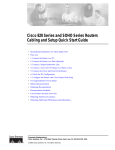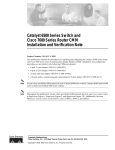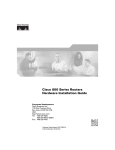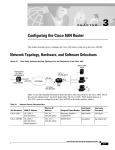Download Cisco Systems 802 Network Card User Manual
Transcript
Installing and Configuring Cisco 802 IDSL and Cisco 804 IDSL Routers Overview Cisco 802 IDSL and Cisco 804 IDSL routers offer high-speed digital connections using an ISDN line and support line rates up to 144 kilobits per second (kbps). Integrated Services Digital Network (ISDN) Digital Subscriber Line (IDSL) expands DSL connectivity for customers who are outside the Service Provider’s range for DSL or for those who are unable to qualify for DSL connections. This document describes the setup and configuration of your routers and contains the following sections: • Before You Start • Unpacking the Router • Connecting Cables to the Router • Configuring the IDSL Router Corporate Headquarters: Cisco Systems, Inc., 170 West Tasman Drive, San Jose, CA 95134-1706 USA Copyright © 2005 Cisco Systems, Inc. All rights reserved. Before You Start The following figure shows a typical setup of the Cisco 804 IDSL router. Cisco 804 IDSL Router Internet Personal computer Power supply Corporate LAN Personal computer Personal computer Personal computer Before You Start Before you begin installing your Cisco IDSL router, read the following topics: • Safety • Preventing Electrostatic Discharge Damage • Preventing Router Damage Safety Before installing the router, read the following warnings: . Warning Only trained and qualified personnel should be allowed to install, replace, or service this equipment. Statement 1030 Warning Read the installation instructions before connecting the system to the power source. Statement 1004 Installing and Configuring Cisco 802 IDSL and Cisco 804 IDSL Routers 2 78-10368-03 Before You Start Warning Before working on a system that has a standby/off switch, turn off the power by pressing the power switch to standby and unplug the power cord. Statement 150 Warning Before working on equipment that is connected to power lines, remove jewelry (including rings, necklaces, and watches). Metal objects will heat up when connected to power and ground and can cause serious burns or weld the metal object to the terminals. Statement 43 Warning The IDSL connection is regarded as a source of voltage that should be inaccessible to user contact. Do not attempt to tamper with or open any public telephone operator (PTO)-provided equipment or connection hardware. Any hardwired connection (other than by a nonremovable, connect-one-time-only plug) must be made only by PTO staff or suitably trained engineers. Statement 23 Warning To avoid electric shock, do not connect safety extra-low voltage (SELV) circuits to telephone-network voltage (TNV) circuits. LAN ports contain SELV circuits, and WAN ports contain TNV circuits. Some LAN and WAN ports both use RJ-45 connectors. Use caution when connecting cables. Statement 1021 Warning Ultimate disposal of this product should be handled according to all national laws and regulations. Statement 1040 Warning If the symbol of suitability with an overlaid cross ( ) appears above a port, you must not connect the port to a public network that follows the European Union standards. Connecting the port to this type of public network can cause severe personal injury or can damage the unit. Statement 1031 Preventing Electrostatic Discharge Damage Electrostatic discharge (ESD) is a transfer of electrostatic charge between bodies of different electrostatic potentials, such as an operator and a piece of electrical equipment. It occurs when electronic components are improperly handled, and it can damage equipment and impair electrical circuitry. Electrostatic discharge is more likely to occur with the combination of synthetic fibers and dry atmosphere. Step 1 Always use the following ESD-prevention procedures when removing and replacing components: Connect the chassis to earth ground with a wire that you provide. Step 2 Wear an ESD-preventive wrist strap that you provide, ensuring that it makes good skin contact. Connect the clip to an unpainted surface of the chassis frame to safely channel unwanted ESD voltages to ground. To properly guard against ESD damage and shocks, the wrist strap and cord must operate effectively. If no wrist strap is available, ground yourself by touching the metal part of the chassis. Always follow the guidelines in the preceding section, “Safety.” Step 3 Do not touch any exposed contact pins or connector shells of interface ports that do not have a cable attached. Installing and Configuring Cisco 802 IDSL and Cisco 804 IDSL Routers 78-10368-03 3 Unpacking the Router If cables are connected at one end only, do not touch the exposed pins at the unconnected end of the cable. Note Caution This device is intended for use in residential and commercial environments only. Periodically check the resistance value of the antistatic strap, which should be between 1 and 10 megohms (Mohms). Preventing Router Damage Use the following guidelines when connecting devices to your router: Warning • Connect the color-coded cables supplied by Cisco to the color-coded ports on the back panel. • If the symbol of suitability ( ) appears above a port, you can connect the port directly to a public network that follows the European Union standards. If the symbol of suitability with an overlaid cross appears above a port, you must not connect the port to a public network that follows the European Union standards. Connecting the port to this type of public network can cause severe personal injury or can damage the unit. Statement 1031 Unpacking the Router Your router package should include the following items: • Ethernet cable (yellow) • IDSL cable (red) • RJ-45 to RJ-11 adapter cable (for use with red IDSL cable) • Desktop power supply • Power cord (black) • Console cable (light blue) • DB-9 to RJ-45 adapter (for use with light blue console cable) • Product documentation Installing and Configuring Cisco 802 IDSL and Cisco 804 IDSL Routers 4 78-10368-03 Connecting Cables to the Router Connecting Cables to the Router The following figures show the router ports. These ports and the cables are color-coded to help you connect the cables correctly. TO HUB TO PC ETHERN ET Cisco 80 LINK CONSOL 2 IDSL E IDSL 10BASE T +5, -24, -71 VDC Cisco 802 IDSL Router TO HUB TO PC ETHERN ET 10 BA Cisco 80 4 IDSL SE T CONSOL E IDSL 1 2 3 +5, -24, -71 VDC 4 Cisco 804 IDSL Router For more information, see the following subsections: • Connecting an Ethernet Device • Connecting a Hub • Connecting a Server, PC, or Workstation • Connecting an IDSL Line • Connecting the Power Supply • Verifying Router Connections Installing and Configuring Cisco 802 IDSL and Cisco 804 IDSL Routers 78-10368-03 5 Connecting Cables to the Router Connecting an Ethernet Device This section describes how to connect a hub, server, PC, or workstation with a 10- or 10/100-Mbps network interface card (NIC). Before connecting an Ethernet device, you need to know the following: Caution • Cisco provides one yellow cable to connect an Ethernet device. If you want to connect more than one device, you must provide additional straight-through cables. See the Cisco 800 Series Routers Hardware Installation Guide for straight-through cable specifications. • The TO HUB/TO PC button corresponds to the Ethernet port on Cisco 802 IDSL routers and to Ethernet port 1 on Cisco 804 IDSL routers. Always connect the yellow cable or Ethernet cable to the yellow ports on the router. Do not connect the cable to an IDSL port or to a Network Termination 1 (NT1) device. Accidently connecting the cable to the wrong port can damage your router. Installing and Configuring Cisco 802 IDSL and Cisco 804 IDSL Routers 6 78-10368-03 Connecting Cables to the Router Connecting a Hub TO HUB TO PC Cisco 804 ETHERN ET 10 BAS ET IDSL CONSO LE IDSL 1 2 3 +5, -24, -71 VDC 4 Cisco 804 IDSL Router 1X 2X SPEED LED 100Bas eTX SO LID 10Base T BLI NK 10/100 3X 4X 1 2 3 4 5 6 7 8 5X 6X 7X 8X MDI MDI-X Cisco Micro Hub 10/100 Step 1 Connect the yellow cable to one of the following ports: • The yellow Ethernet port on your Cisco 802 IDSL router. • Any of the yellow Ethernet ports on your Cisco 804 IDSL router. Step 2 Connect the other end of the cable to the hub. Step 3 Check the LED corresponding to the connected port after router power-up: Step 4 • The LINK LED is on the Cisco 802 IDSL back panel. • ETHERNET 1, 2, 3, and 4 LEDs are on the Cisco 804 IDSL front panel. If the LED corresponding to the connected port is not on, do the following: • If the LINK or ETHERNET 1 LED is not on, try pressing the TO HUB/TO PC button. • If the ETHERNET 2, 3, or 4 LED is not on, press the equivalent of the router TO HUB/TO PC button on your hub. Installing and Configuring Cisco 802 IDSL and Cisco 804 IDSL Routers 78-10368-03 7 Connecting Cables to the Router Connecting a Server, PC, or Workstation TO HUB TO PC Cisco 804 ETHERN ET 10 BAS ET IDSL CONSO LE +5, -24, IDSL 1 2 3 -71 VDC 4 Cisco 804 IDSL Router OK SER 0 AUX LAN AUX PC Connect the yellow cable to one of the following ports: • The yellow Ethernet port on your Cisco 802 IDSL router. • Any of the yellow Ethernet ports on your Cisco 804 IDSL router. Step 1 Connect the other end of the cable to the server, PC, or workstation. Step 2 Check the LED corresponding to the connected port after router power-up: • The LINK LED is on the Cisco 802 IDSL back panel. • ETHERNET 1, 2, 3, and 4 LEDs are on the Cisco 804 IDSL front panel. Step 3 If the LINK or ETHERNET 1 LED is not on, try pressing the TO HUB/TO PC button. Step 4 If the ETHERNET 2, 3, or 4 LED is not on, see the Cisco 800 Series Routers Hardware Installation Guide. Installing and Configuring Cisco 802 IDSL and Cisco 804 IDSL Routers 8 78-10368-03 Connecting Cables to the Router Connecting an IDSL Line Caution Always connect the yellow cable or Ethernet cable to the yellow ports on the router. Do not connect the cable to an IDSL port or to a Network Termination 1 (NT1) device. Accidently connecting the cable to the wrong port can damage your router. TO HUB TO PC ETHERN ET 10 BAS Cisco 80 4 IDSL ET CONSO LE IDSL 1 2 3 +5, -24, -71 VDC 4 Cisco 804 IDSL Router IDSL wall jack RJ-45-to-RJ-11 adapter cable Step 1 Connect the red cable to the red IDSL port. Step 2 Connect the other end of the cable to the IDSL wall jack. If your wall jack has an RJ-11 connector, attach the RJ-45-to-RJ-11 adapter cable to the red cable, and then connect the RJ-11 connector to the IDSL wall jack. Installing and Configuring Cisco 802 IDSL and Cisco 804 IDSL Routers 78-10368-03 9 Connecting Cables to the Router Connecting the Power Supply TO HUB TO PC Cisco 80 ETHERN ET 10 BAS ET CONSO 4 IDSL LE IDSL 1 +5, -24, -71 VDC 2 3 4 Cisco 804 IDSL Router 2 To electrical outlet Desktop power supply Step 1 Make sure the router power is off. Press the power switch to standby ( Step 2 Connect the power supply cable to the 8-pin connector on the router. Step 3 Connect the power cord to the desktop power supply. Step 4 Connect the other end of the power cord to an electrical outlet. Step 5 Turn on the router. Press the power switch to on (|). ). Verifying Router Connections Verify the power connection and all other connections (links) by checking the LEDs in the table below. If the LEDs are not on, see the troubleshooting information in the Cisco 800 Series Routers Hardware Installation Guide. Power/Link LEDs To Check Normal Patterns Power OK On To hub, server, PC, or workstation Cisco 802 IDSL back panel: LINK LED On To IDSL network using IDSL port NT1, LINE, CH1, or CH2 Cisco 804 IDSL front panel: ETHERNET 1, 2, 3, and 4 LEDs On (CH1 or CH2 is on only when the router has an active data connection. With a 64 kbps connection, only CH1 is on. With a 128 or 144 kbps connection, both CH1 and CH2 are on). Installing and Configuring Cisco 802 IDSL and Cisco 804 IDSL Routers 10 78-10368-03 Configuring the IDSL Router Configuring the IDSL Router You can configure your Cisco IDSL router using the Cisco IOS command-line interface or the Cisco 800 Fast Step application. For information about using Cisco 800 Fast Step, refer to the Cisco 800 DSL Connection Kit document in the product accessory kit or on Cisco Connection Online (CCO). The following procedures are examples of how to configure the Cisco IDSL router using Cisco IOS commands. For more information about Cisco IOS commands, refer to the Cisco IOS documentation set on Cisco.com. Basic IDSL Configuration The following is an example of a typical IDSL configuration. Step 1 In global configuration mode, specify a name for the router. For example: router(config)# hostname 802 Step 2 Specify a username and password. The username is the destination router’s hostname. The password must be the same for both the host and destination routers. For example: router(config)# username isp password cisco Step 3 Set the switch type. For example: router(config)# isdn switch-type basic-5ess Step 4 Set the BRI interface to use the ISDN physical connection as a leased-line service. The following example sets the line speed at 128 kbps: router(config)# isdn leased-line bri0 128 Step 5 Configure DHCP relay pool name. For example: router(config)# ip dhcp pool DHCPpoolLAN_0 Step 6 Set the DHCP pool of addresses. For example: router(dhcp-config)# network 192.168.1.0 255.255.255.0 Step 7 Set the IP addresses of the DNS servers. For example: router(dhcp-config)# dns-server 172.29.20.41 172.29.20.51 Step 8 Set the NetBIOS servers. For example: router(dhcp-config)# netbios-name-server 172.29.20.41 172.29.20.51 Step 9 Set the Ethernet 0 IP address as the default gateway. For example: router(dhcp-config)# default-router 192.168.1.1 Step 10 Exit to global configuration mode. router(dhcp-config)# exit router(config)# Step 11 Define the IP addresses of the DNS servers. For example: router(config)# ip name-server 172.29.20.41 router(config)# ip name-server 172.29.20.51 Installing and Configuring Cisco 802 IDSL and Cisco 804 IDSL Routers 78-10368-03 11 Example of Basic Configuration Output Step 12 Change to interface command mode. For example: router(config)# interface ethernet0 router(config-if)# Step 13 Enter the IP address and subnet mask for the LAN. For example: router(config-if)# ip address 192.168.1.1 255.255.255.0 Step 14 Enable Network Address Translation (NAT) on your LAN. The inside network address is not directly routed to the Internet but is subject to translation to a routable address outside the LAN. router(config-if)# ip nat inside Step 15 Set the BRI interface IP address. In the following example, IP addresses are dynamically assigned: router(config-if)# interface bri0 router(config-if)# ip address negotiated Step 16 Enable PPP. router(config-if)# encapsulation ppp Step 17 Configure CHAP authentication. router(config-if)# ppp authentication chap Step 18 Configure a valid Internet address to which the inside network address will be translated. router(config-if)# ip nat outside Step 19 Define the router hostname and password to authenticate. For example: router(config-if)# ppp chap hostname 802 router(config-if)# ppp chap password cisco Step 20 Exit to global configuration mode. Add default route and interface. For example: router(config-if)# exit router(config)# ip route 0.0.0.0 0.0.0.0 bri0 Step 21 End configuration mode. router(config)# end router# Step 22 In user mode, set global NAT commands. In the following example, all inside network addresses assigned to interface BRI0 are configured for translation, and the access list that contains the inside network addresses is defined. router# ip nat inside source list 1 interface bri0 overload router# access-list 1 permit 192.168.1.0 0.0.0.255 Step 23 Save your configuration. router# copy running-config startup-config Example of Basic Configuration Output Current configuration: ! version 12.0 no service pad Installing and Configuring Cisco 802 IDSL and Cisco 804 IDSL Routers 12 78-10368-03 Example of Basic Configuration Output service timestamps debug uptime service timestamps log uptime no service password-encryption ! hostname cisco802 ! ! ! ! ip subnet-zero ! isdn switch-type basic-5ess isdn leased-line BRI0 128 ip dhcp pool DHCPoolLAN_0 network 192.168.1.0 255.255.255.0 dns-server 172.29.20.41 172.29.20.51 netbios-name-server 172.29.20.41 172.29.20.51 default-router 192.168.1.1 ip name-server 172.29.20.41 ip name-server 172.29.20.51 ! ! interface Ethernet0 ip address 192.168.1.1 255.255.255.0 no ip directed-broadcast ip nat inside ! interface BRI0 ip unnumbered negotiated no ip directed-broadcast encapsulation ppp ppp authentication chap ip nat outside ppp chap hostname 802 ppp chap password cisco ! ip classless ip route 0.0.0.0 0.0.0.0 bri 0 ! ip nat inside source list 1 interface bri0 overload access-list 1 permit 192.168.1.0 0.0.0.255 ! line con 0 transport input none stopbits 1 line vty 0 4 end cisco802# Installing and Configuring Cisco 802 IDSL and Cisco 804 IDSL Routers 78-10368-03 13 IDSL Configuration with Frame Relay IDSL Configuration with Frame Relay The following procedure is an example of how to configure IDSL with Frame Relay. Step 1 In global configuration mode, specify a name for the router. For example: router(config)# hostname 802 Step 2 Specify a username and password. The username is the destination router’s hostname. The password must be the same for both the host and destination routers. For example: router(config)# username isp password cisco Step 3 Set the switch type. For example: router(config)# isdn switch-type basic-5ess Step 4 Set the BRI interfaces to use the ISDN physical connection as a leased-line service. The following example sets the line speed at 144 kbps: router(config)# isdn leased-line bri0 144 router(config)# isdn leased-line bri0.1 144 Step 5 Change to interface command mode. For example: router(config)# interface ethernet0 Step 6 Enter an IP address. For example: router(config-if)# ip address 192.168.2.1 255.255.255.0 Step 7 Enable Network Address Translation (NAT) on your LAN. The inside network address is not directly routed to the Internet but is subject to translation to a routable address outside the LAN. router(config-if)# ip nat inside Step 8 Change to BRI interface. router(config-if)# interface bri0 Step 9 Configure interface with no IP address. router(config-if)# no ip address Step 10 Configure NAT so that the inside network address will be translated to a valid Internet address. router(config-if)# ip nat outside Step 11 Specify the encapsulation type. In the following example, IETF is used to connect to non-Cisco routers. router(config-if)# encapsulation frame-relay ietf Step 12 Specify the Local Management Interface (LMI) type used by the Frame Relay switch. For example: router(config-if)# frame-relay lmi-type ansi Step 13 Specify the subinterface point-to-point. For example: router(config-if)# interface bri0:1 point-to-point Step 14 Specify the IP address on the subinterface. For example: router(config-if)# ip address 209.188.2.2 255.255.255.0 Installing and Configuring Cisco 802 IDSL and Cisco 804 IDSL Routers 14 78-10368-03 Example of Frame Relay Configuration Output Step 15 Specify a DLCI number that is used to connect to the Internet service provider. For example: router(config)# frame-relay interface dlci 16 ieft Step 16 End configuration mode. router(config)# end router# Step 17 In user mode, set global NAT commands. In the following example, all inside network addresses assigned to interface BRI0 are configured for translation, and the access list that contains the inside network addresses is defined. router# ip nat inside source list 1 interface bri0 overload router# access-list 1 permit 192.168.1.0 0.0.0.255 Step 18 Save your configuration. router# copy running-config startup-config Example of Frame Relay Configuration Output Current configuration: ! ! version 12.0 service timestamps debug uptime service timestamps log uptime ! hostname c802idsl username isp password 0 cisco ! ! ip subnet-zero ! isdn switch-type basic-5ess isdn leased-line BRI0 144 isdn leased-line BRI0.1 144 ! ! interface Ethernet0 ip address 192.168.2.1 255.255.255.0 ip nat inside ! interface BRI0 no ip address encapsulation frame-relay IETF frame-relay lmi-type ansi ! interface BRI0.1 point-to-point ip address 209.188.2.2 255.255.255.0 frame-relay interface-dlci 16 IETF ip nat outside ! ip nat inside source list 1 interface bri0:1 overload access-list 1 permit 192.168.2.0 0.0.0.255 Installing and Configuring Cisco 802 IDSL and Cisco 804 IDSL Routers 78-10368-03 15 Troubleshooting Using Debug Commands ip classless ip route 0.0.0.0 0.0.0.0 209.188.2.1 ! ! line con 0 exec-timeout 0 0 transport input none stopbits 1 line vty 0 4 ! end Troubleshooting Using Debug Commands In general, Cisco recommends that you use these commands with the direction of your technical support representative. Using the debug commands can disrupt operation of the router when your internetwork is experiencing a high-load condition. When you finish using a debug command, remember to disable it with the specific no debug command or with the no debug all command. To minimize the impact of using debug commands, use the following procedure: Step 1 Enter the following command from global configuration mode: router (config)# no logging console This command disables all logging to the terminal or PC that you are troubleshooting the software from. (To reenable logging, enter the global configuration mode logging console enable command.) Step 2 To use the debug commands, do the following: a. Access any router port remotely using Telnet, and enter the following command while in user EXEC mode: router> enable b. To show debug command output and error messages, enter the following command: router> terminal monitor c. To disable logging on the virtual terminal, enter the following command: router> terminal no monitor d. Enter the desired debug commands. Performing this procedure minimizes the load created because the console port no longer needs to generate character-by-character processor interrupts. The following table describes debug commands, problems your router might be experiencing, and solutions to the problems. An output example from each command appears after the table. Installing and Configuring Cisco 802 IDSL and Cisco 804 IDSL Routers 16 78-10368-03 Troubleshooting Using Debug Commands Command Possible Problem Solution show isdn status (user EXEC mode). • Improperly connected cable. • Refer to troubleshooting information in Cisco 800 Series Routers Hardware Installation Guide. • Damaged IDSL cable. • Order a new red IDSL cable from your Cisco reseller. • Problem with IDSL line. • Contact your telephone service provider to report a problem. See output 1 example following this table. If the problem continues after these steps, call your Cisco reseller. • Software configuration error for router connected to Cisco 802 IDSL or Cisco 804 IDSL router. • Check your router configuration. See the documentation that shipped with your router for more information. debug ppp negotiation, • PAP or CHAP authentication debug ppp failed. authentication (privileged EXEC mode) • For PAP, check the settings of the PAP hostname and password for correct spelling and use of uppercase and lowercase letters. If settings are incorrect, reconfigure them. See output 2 example following this table. • For CHAP, clear the existing hostname and password. Reconfigure the hostname and password. Output 1 Example (show isdn status) The current ISDN Switchtype = basic-ni1 ISDN BRI0 interface Layer 1 Status: DEACTIVATED Layer 2 Status: Layer 2 NOT Activated Layer 3 Status: No Active Layer 3 Call(s) Activated dsl 0 CCBs = 0 Total Allocated ISDN CCBs = 0 isdn# ISDN BR0:TX -> RRp sapi = 0 tei = 80 nr = 1 ISDN BR0:RX <- RRf sapi = 0 tei = 80 nr = 1 isdn# ISDN BR0:TX -> RRp sapi = 0 tei = 81 nr = 1 ISDN BR0:RX <- RRf sapi = 0 tei = 81 nr = 1 ISDN BR0:TX -> RRp sapi = 0 tei = 80 nr = 1 ISDN BR0:RX <- RRf sapi = 0 tei = 80 nr = 1 isdn#und all isdn#show isdn st The current ISDN Switchtype = basic-dms100 ISDN BRI0 interface Layer 1 Status: ACTIVE Layer 2 Status: TEI = 80, State = MULTIPLE_FRAME_ESTABLISHED TEI = 81, State = MULTIPLE_FRAME_ESTABLISHED Layer 3 Status: Installing and Configuring Cisco 802 IDSL and Cisco 804 IDSL Routers 78-10368-03 17 Obtaining Documentation No Active Layer 3 Call(s) Activated dsl 0 CCBs = 0 Output 2 Example (debug ppp negotiation and debug ppp authentication) pico#ping 192.9.198.1 Type escape sequence to abort. Sending 5, 100-byte ICMP Echos to 192.9.198.1, timeout is 2 seconds: %LINK-3-UPDOWN: Interface BRI0: B-Channel 1, changed state to up %LINK-5-CHANGED: Interface BRI0: B-Channel 1, changed state to up ppp: sending CONFREQ, type = 3 (CI_AUTHTYPE), value = C223/5 ppp: sending CONFREQ, type = 5 (CI_MAGICNUMBER), value = 28CEEF99 ppp: received config for type = 3 (AUTHTYPE) value = C223 value = 5 acked ppp: received config for type = 5 (MAGICNUMBER) value = 1E23F5C acked PPP BRI0: B-Channel 1: state = ACKSENT fsm_rconfack(C021): rcvd id E4 ppp: config ACK received, type. = 3 (CI_AUTHTYPE), value = C223 ppp: config ACK received, type = 5 (CI_MAGICNUMBER), value = 28CEEF99 BRI0: B-Channel 1: PPP AUTH CHAP input code = 1 id = 82 len = 16 BRI0: B-Channel 1: PPP AUTH CHAP input code = 2 id = 95 len = 28 BRI0: B-Channel 1: PPP AUTH CHAP input code = 4 id = 82 len = 21 BRI0: B-Channel 1: Failed CHAP authentication with remote. Remote message is: MD compare failed ppp: sending CONFREQ, type = 3 (CI_AUTHTYPE), value = C223/5 ppp: sending CONFREQ, type = 5 (CI_MAGICNUMBER), value = 28CEEFDB %LINK-3-UPDOWN: Interface BRI0: B-Channel 1, changed state to down %LINK-5-CHANGED: Interface BRI0: B-Channel 1, changed state to down %LINK-3-UPDOWN: Interface BRI0: B-Channel 1, changed state to up %LINK-5-CHANGED: Interface BRI0: B-Channel 1, changed state to up ppp: sending CONFREQ, type = 3 (CI_AUTHTYPE), value = C223/5 ppp: sending CONFREQ, type = 5 (CI_MAGICNUMBER), value = 28CEF76C ppp: received config for type = 3 (AUTHTYPE) value = C223 value = 5 acked ppp: received conf.ig for type = 5 (MAGICNUMBER) value = 1E24718 acked PPP BRI0: B-Channel 1: state = ACKSENT fsm_rconfack(C021): rcvd id E6 ppp: config ACK received, type = 3 (CI_AUTHTYPE), value = C223 ppp: config ACK received, type = 5 (CI_MAGICNUMBER), value = 28CEF76C BRI0: B-Channel 1: PPP AUTH CHAP input code = 1 id = 83 len = 16 BRI0: B-Channel 1: PPP AUTH CHAP input code = 2 id = 96 len = 28 BRI0: B-Channel 1: PPP AUTH CHAP input code = 4 id = 83 len = 21 BRI0: B-Channel 1: Failed CHAP authentication with remote. Remote message is: MD compare failed Obtaining Documentation Cisco documentation and additional literature are available on Cisco.com. Cisco also provides several ways to obtain technical assistance and other technical resources. These sections explain how to obtain technical information from Cisco Systems. Cisco.com You can access the most current Cisco documentation at this URL: http://www.cisco.com/univercd/home/home.htm Installing and Configuring Cisco 802 IDSL and Cisco 804 IDSL Routers 18 78-10368-03 Documentation Feedback You can access the Cisco website at this URL: http://www.cisco.com You can access international Cisco websites at this URL: http://www.cisco.com/public/countries_languages.shtml Documentation DVD Cisco documentation and additional literature are available in a Documentation DVD package, which may have shipped with your product. The Documentation DVD is updated regularly and may be more current than printed documentation. The Documentation DVD package is available as a single unit. Registered Cisco.com users (Cisco direct customers) can order a Cisco Documentation DVD (product number DOC-DOCDVD=) from the Ordering tool or Cisco Marketplace. Cisco Ordering tool: http://www.cisco.com/en/US/partner/ordering/ Cisco Marketplace: http://www.cisco.com/go/marketplace/ Ordering Documentation You can find instructions for ordering documentation at this URL: http://www.cisco.com/univercd/cc/td/doc/es_inpck/pdi.htm You can order Cisco documentation in these ways: • Registered Cisco.com users (Cisco direct customers) can order Cisco product documentation from the Ordering tool: http://www.cisco.com/en/US/partner/ordering/ • Nonregistered Cisco.com users can order documentation through a local account representative by calling Cisco Systems Corporate Headquarters (California, USA) at 408 526-7208 or, elsewhere in North America, by calling 1 800 553-NETS (6387). Documentation Feedback You can send comments about technical documentation to [email protected]. You can submit comments by using the response card (if present) behind the front cover of your document or by writing to the following address: Cisco Systems Attn: Customer Document Ordering 170 West Tasman Drive San Jose, CA 95134-9883 We appreciate your comments. Installing and Configuring Cisco 802 IDSL and Cisco 804 IDSL Routers 78-10368-03 19 Cisco Product Security Overview Cisco Product Security Overview Cisco provides a free online Security Vulnerability Policy portal at this URL: http://www.cisco.com/en/US/products/products_security_vulnerability_policy.html From this site, you can perform these tasks: • Report security vulnerabilities in Cisco products. • Obtain assistance with security incidents that involve Cisco products. • Register to receive security information from Cisco. A current list of security advisories and notices for Cisco products is available at this URL: http://www.cisco.com/go/psirt If you prefer to see advisories and notices as they are updated in real time, you can access a Product Security Incident Response Team Really Simple Syndication (PSIRT RSS) feed from this URL: http://www.cisco.com/en/US/products/products_psirt_rss_feed.html Reporting Security Problems in Cisco Products Cisco is committed to delivering secure products. We test our products internally before we release them, and we strive to correct all vulnerabilities quickly. If you think that you might have identified a vulnerability in a Cisco product, contact PSIRT: Tip • Emergencies — [email protected] • Nonemergencies — [email protected] We encourage you to use Pretty Good Privacy (PGP) or a compatible product to encrypt any sensitive information that you send to Cisco. PSIRT can work from encrypted information that is compatible with PGP versions 2.x through 8.x. Never use a revoked or an expired encryption key. The correct public key to use in your correspondence with PSIRT is the one that has the most recent creation date in this public key server list: http://pgp.mit.edu:11371/pks/lookup?search=psirt%40cisco.com&op=index&exact=on In an emergency, you can also reach PSIRT by telephone: • 1 877 228-7302 • 1 408 525-6532 Obtaining Technical Assistance For all customers, partners, resellers, and distributors who hold valid Cisco service contracts, Cisco Technical Support provides 24-hour-a-day, award-winning technical assistance. The Cisco Technical Support Website on Cisco.com features extensive online support resources. In addition, Cisco Technical Assistance Center (TAC) engineers provide telephone support. If you do not hold a valid Cisco service contract, contact your reseller. Installing and Configuring Cisco 802 IDSL and Cisco 804 IDSL Routers 20 78-10368-03 Obtaining Technical Assistance Cisco Technical Support Website The Cisco Technical Support Website provides online documents and tools for troubleshooting and resolving technical issues with Cisco products and technologies. The website is available 24 hours a day, 365 days a year, at this URL: http://www.cisco.com/techsupport Access to all tools on the Cisco Technical Support Website requires a Cisco.com user ID and password. If you have a valid service contract but do not have a user ID or password, you can register at this URL: http://tools.cisco.com/RPF/register/register.do Note Use the Cisco Product Identification (CPI) tool to locate your product serial number before submitting a web or phone request for service. You can access the CPI tool from the Cisco Technical Support Website by clicking the Tools & Resources link under Documentation & Tools. Choose Cisco Product Identification Tool from the Alphabetical Index drop-down list, or click the Cisco Product Identification Tool link under Alerts & RMAs. The CPI tool offers three search options: by product ID or model name; by tree view; or for certain products, by copying and pasting show command output. Search results show an illustration of your product with the serial number label location highlighted. Locate the serial number label on your product and record the information before placing a service call. Submitting a Service Request Using the online TAC Service Request Tool is the fastest way to open S3 and S4 service requests. (S3 and S4 service requests are those in which your network is minimally impaired or for which you require product information.) After you describe your situation, the TAC Service Request Tool provides recommended solutions. If your issue is not resolved using the recommended resources, your service request is assigned to a Cisco TAC engineer. The TAC Service Request Tool is located at this URL: http://www.cisco.com/techsupport/servicerequest For S1 or S2 service requests or if you do not have Internet access, contact the Cisco TAC by telephone. (S1 or S2 service requests are those in which your production network is down or severely degraded.) Cisco TAC engineers are assigned immediately to S1 and S2 service requests to help keep your business operations running smoothly. To open a service request by telephone, use one of the following numbers: Asia-Pacific: +61 2 8446 7411 (Australia: 1 800 805 227) EMEA: +32 2 704 55 55 USA: 1 800 553-2447 For a complete list of Cisco TAC contacts, go to this URL: http://www.cisco.com/techsupport/contacts Definitions of Service Request Severity To ensure that all service requests are reported in a standard format, Cisco has established severity definitions. Severity 1 (S1)—Your network is “down,” or there is a critical impact to your business operations. You and Cisco will commit all necessary resources around the clock to resolve the situation. Installing and Configuring Cisco 802 IDSL and Cisco 804 IDSL Routers 78-10368-03 21 Severity 2 (S2)—Operation of an existing network is severely degraded, or significant aspects of your business operation are negatively affected by inadequate performance of Cisco products. You and Cisco will commit full-time resources during normal business hours to resolve the situation. Severity 3 (S3)—Operational performance of your network is impaired, but most business operations remain functional. You and Cisco will commit resources during normal business hours to restore service to satisfactory levels. Severity 4 (S4)—You require information or assistance with Cisco product capabilities, installation, or configuration. There is little or no effect on your business operations. Obtaining Additional Publications and Information Information about Cisco products, technologies, and network solutions is available from various online and printed sources. • Cisco Marketplace provides a variety of Cisco books, reference guides, and logo merchandise. Visit Cisco Marketplace, the company store, at this URL: http://www.cisco.com/go/marketplace/ • Cisco Press publishes a wide range of general networking, training and certification titles. Both new and experienced users will benefit from these publications. For current Cisco Press titles and other information, go to Cisco Press at this URL: http://www.ciscopress.com • Packet magazine is the Cisco Systems technical user magazine for maximizing Internet and networking investments. Each quarter, Packet delivers coverage of the latest industry trends, technology breakthroughs, and Cisco products and solutions, as well as network deployment and troubleshooting tips, configuration examples, customer case studies, certification and training information, and links to scores of in-depth online resources. You can access Packet magazine at this URL: http://www.cisco.com/packet • iQ Magazine is the quarterly publication from Cisco Systems designed to help growing companies learn how they can use technology to increase revenue, streamline their business, and expand services. The publication identifies the challenges facing these companies and the technologies to help solve them, using real-world case studies and business strategies to help readers make sound technology investment decisions. You can access iQ Magazine at this URL: http://www.cisco.com/go/iqmagazine • Internet Protocol Journal is a quarterly journal published by Cisco Systems for engineering professionals involved in designing, developing, and operating public and private internets and intranets. You can access the Internet Protocol Journal at this URL: http://www.cisco.com/ipj • World-class networking training is available from Cisco. You can view current offerings at this URL: http://www.cisco.com/en/US/learning/index.html Obtaining Additional Publications and Information CCSP, CCVP, the Cisco Square Bridge logo, Follow Me Browsing, and StackWise are trademarks of Cisco Systems, Inc.; Changing the Way We Work, Live, Play, and Learn, and iQuick Study are service marks of Cisco Systems, Inc.; and Access Registrar, Aironet, ASIST, BPX, Catalyst, CCDA, CCDP, CCIE, CCIP, CCNA, CCNP, Cisco, the Cisco Certified Internetwork Expert logo, Cisco IOS, Cisco Press, Cisco Systems, Cisco Systems Capital, the Cisco Systems logo, Cisco Unity, Empowering the Internet Generation, Enterprise/Solver, EtherChannel, EtherFast, EtherSwitch, Fast Step, FormShare, GigaDrive, GigaStack, HomeLink, Internet Quotient, IOS, IP/TV, iQ Expertise, the iQ logo, iQ Net Readiness Scorecard, LightStream, Linksys, MeetingPlace, MGX, the Networkers logo, Networking Academy, Network Registrar, Packet, PIX, Post-Routing, Pre-Routing, ProConnect, RateMUX, ScriptShare, SlideCast, SMARTnet, StrataView Plus, TeleRouter, The Fastest Way to Increase Your Internet Quotient, and TransPath are registered trademarks of Cisco Systems, Inc. and/or its affiliates in the United States and certain other countries. All other trademarks mentioned in this document or Website are the property of their respective owners. The use of the word partner does not imply a partnership relationship between Cisco and any other company. (0502R) Copyright © 2005 Cisco Systems, Inc. All rights reserved. Installing and Configuring Cisco 802 IDSL and Cisco 804 IDSL Routers 78-10368-03 23 Obtaining Additional Publications and Information Installing and Configuring Cisco 802 IDSL and Cisco 804 IDSL Routers 24 78-10368-03



































